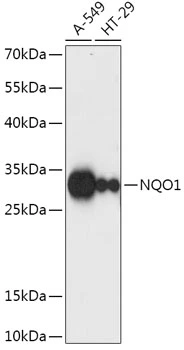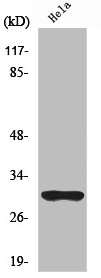
WB analysis of various sample lysates using GTX32756 NQO1 antibody. The signal was developed with ECL plus-Enhanced. Dilution : 1:1000 Loading : 25microg per lane
NQO1 antibody
GTX32756
ApplicationsImmunoFluorescence, Western Blot, ImmunoCytoChemistry
Product group Antibodies
TargetNQO1
Overview
- SupplierGeneTex
- Product NameNQO1 antibody
- Delivery Days Customer9
- Application Supplier NoteWB: 1:500 - 1:2000. ICC/IF: 1:50 - 1:200. *Optimal dilutions/concentrations should be determined by the researcher.Not tested in other applications.
- ApplicationsImmunoFluorescence, Western Blot, ImmunoCytoChemistry
- CertificationResearch Use Only
- ClonalityPolyclonal
- ConjugateUnconjugated
- Gene ID1728
- Target nameNQO1
- Target descriptionNAD(P)H quinone dehydrogenase 1
- Target synonymsDHQU, DIA4, DTD, NMOR1, NMORI, QR1, NAD(P)H dehydrogenase [quinone] 1, DT-diaphorase, NAD(P)H dehydrogenase, quinone 1, NAD(P)H-quinone oxidoreductase, NAD(P)H:Quinone acceptor oxidoreductase type 1, NAD(P)H:menadione oxidoreductase 1, NAD(P)H:quinone oxidoreductase 1, NAD(P)H:quinone oxireductase, azoreductase, diaphorase (NADH/NADPH) (cytochrome b-5 reductase), diaphorase-4, dioxin-inducible 1, menadione reductase, phylloquinone reductase, quinone reductase 1
- HostRabbit
- IsotypeIgG
- Protein IDP15559
- Protein NameNAD(P)H dehydrogenase [quinone] 1
- Scientific DescriptionThis gene is a member of the NAD(P)H dehydrogenase (quinone) family and encodes a cytoplasmic 2-electron reductase. This FAD-binding protein forms homodimers and reduces quinones to hydroquinones. This proteins enzymatic activity prevents the one electron reduction of quinones that results in the production of radical species. Mutations in this gene have been associated with tardive dyskinesia (TD), an increased risk of hematotoxicity after exposure to benzene, and susceptibility to various forms of cancer. Altered expression of this protein has been seen in many tumors and is also associated with Alzheimers disease (AD). Alternate transcriptional splice variants, encoding different isoforms, have been characterized. [provided by RefSeq, Jul 2008]
- Storage Instruction-20°C or -80°C,2°C to 8°C
- UNSPSC12352203



![FACS (Intracellular staining) analysis of A549 cells using GTX30626 NQO1 antibody [A180]. Filled histogram : primary antibody Open histogram : isotype control](https://www.genetex.com/upload/website/prouct_img/normal/GTX30626/GTX30626_102_FACS_w_23060722_243.webp)
![ELISA analysis of antigen using GTX60523 NQO1 antibody [4D12]. Black : Control antigen 100ng Purple : Antigen 10ng Blue : Antigen 50ng Red : Antigen 100ng](https://www.genetex.com/upload/website/prouct_img/normal/GTX60523/GTX60523_20170912_ELISA_w_23061123_645.webp)
![ELISA analysis of antigen using GTX60524 NQO1 antibody [1A11]. Black : Control antigen 100ng Purple : Antigen 10ng Blue : Antigen 50ng Red : Antigen 100ng](https://www.genetex.com/upload/website/prouct_img/normal/GTX60524/GTX60524_20170912_ELISA_w_23061123_544.webp)

